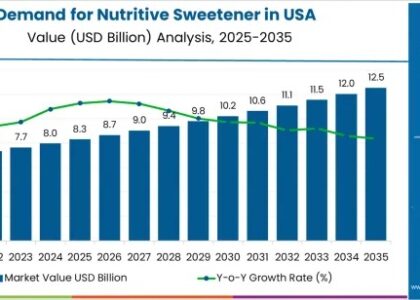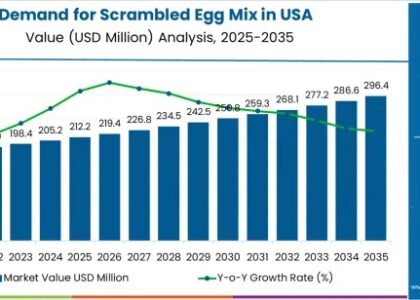Introduction
In today’s world, the increasing concern for environmental conservation and sustainable practices has paved the way for innovative solutions like biodegradable films. The Biodegradable Films Market is rapidly expanding, offering an eco-friendly alternative to traditional plastic films that contribute to pollution and environmental degradation. This article delves deep into the realm of biodegradable films, exploring their production, applications, benefits, and their role in creating a greener and cleaner future.
What are Biodegradable Films?
Biodegradable films are a type of thin, flexible material that can decompose naturally over time when exposed to the environment. These films are usually derived from renewable sources like plant-based materials and serve as an eco-conscious alternative to petroleum-based plastics. Biodegradable films hold immense potential to replace single-use plastics in various industries, reducing the carbon footprint and mitigating the harmful impact on the environment.
With a projected CAGR of 5.6%, the global biodegradable films market is set to experience impressive growth, elevating its value from US$ 1,040.1 Million in 2022 to an estimated US$ 1.7 Bn by 2032. The market’s continuous ascent is evident, as it was valued at US$ 1,000.5 Million in 2021, and is expected to exhibit a Y-o-Y growth of 5.4% in 2022.
Download Sample Report to learn about recent in the Biodegradable Films industry observed by FMI.: https://www.futuremarketinsights.com/reports/sample/rep-gb-11372
Advantages of Biodegradable Films
1. Environmental Benefits
Biodegradable films are designed to break down naturally, reducing the burden of plastic waste on the environment. Unlike traditional plastics that take hundreds of years to decompose, biodegradable films offer a more sustainable solution, helping to keep landfills and oceans free from harmful plastic debris.
2. Versatility in Applications
Biodegradable films find extensive applications in various industries. They are used in packaging for food products, electronics, pharmaceuticals, and agricultural products. Additionally, they serve as an excellent material for single-use items like shopping bags and cutlery, minimizing their environmental impact.
3. Reduced Carbon Footprint
As biodegradable films are derived from renewable resources, their production typically results in lower greenhouse gas emissions compared to conventional plastics. This reduction in the carbon footprint contributes to the fight against climate change and global warming.
4. Promoting a Circular Economy
Biodegradable films encourage a circular economy by enabling the efficient use of resources. They can be composted and recycled to create new products, fostering a sustainable approach to material consumption.
Biodegradable Films Market: Applications and Industries
Biodegradable films have a broad range of applications across diverse industries, thanks to their eco-friendly nature and versatile characteristics. Some of the key applications include:
1. Packaging Industry
The packaging industry is one of the primary beneficiaries of biodegradable films. From food packaging to electronics, biodegradable films offer an excellent alternative to conventional plastic wraps, reducing environmental impact and promoting sustainable packaging solutions.
2. Agriculture and Horticulture
In agriculture, biodegradable films find application in mulching and crop protection. These films help regulate soil temperature, retain moisture, and prevent weed growth, improving overall crop yield and sustainability.
Unlock Exclusive Savings of up to 30% on Tailoring this Report.
Global Biodegradable Films Market: Geographical Outlook
The popularity of biodegradable films in North America and Europe is expected to gaining traction owing to local governments push toward sustainability and manufacturers increased research and development activities. The ban on plastic and consumers’ acceptance for biodegradable packaging options are expected to speed up the growth of the biodegradable films market in the coming decade.
Japan, China and India are planning to reduce 100% of single-use plastic by the end of 2025, which is expected to boost the demand for biodegradable films in the Asia Pacific region. Latin America and Middle East & Africa regions witnessed sluggish growth for biodegradable films market in the past five years, which is projected to accelerate in the next decade.
Global Biodegradable Films Market: Key Players
Some of the key players operating in the global biodegradable films market are as follows:
- Taghleef Industries Group
- Cortec Corporation
- Clondalkin Group
- Futamura Group
- Storopack, Inc.
- Transilwrap Co., Inc.
- Accredo Packaging, Inc.
- POLYNOVA Industries Inc.
- Tipa Corporation
- Plastiroll Oy Ltd.
The report is a compilation of first-hand information, qualitative and quantitative assessment by industry analysts, inputs from industry experts and industry participants across the value chain. The report provides an in-depth analysis of parent market trends, macroeconomic indicators and governing factors along with market attractiveness as per segments. The report also maps the qualitative impact of various market factors on biodegradable films market segments and geographies.
Customize Your Report: Tailor the Exclusive Insights to Your Biodegradable Films Market Strategy!@
https://www.futuremarketinsights.com/customization-available/rep-gb-11372
Global Biodegradable Films Market: Segmentation
The global biodegradable films market has been segmented into material, application, thickness, and end-user industry.
On the basis of material, the global biodegradable films market has been segmented into:
- Bio-LDPE (Low Density Polyethylene)
- Bio-MDPE (Low Density Polyethylene)
- Bio-HDPE (Low Density Polyethylene)
- Bio-based PLA (Polylactic Acid)
- Others
On the basis of application, the global biodegradable films market has been segmented into:
- Bags
- Mulch Films
- Wrapping Films
- Liners
- Others (Sheets, etc.)
On the basis of thickness, the global biodegradable films market has been segmented into:
- Up to 1 mil
- 1-3 mil
- Above 3 mil
On the basis of end-user industry, the global biodegradable films market has been segmented into:
- Food & Beverages
- Healthcare
- Personal Care & Cosmetics
- Agriculture
- Waste Management
- Others
On the basis of Region, the global biodegradable films market has been segmented into:
- North America
- Latin America
- Europe
- Middle east and Africa
- East Asia
- South Asia
- Oceania
Get Ahead with Detailed Market Intelligence: Purchase Now to Access Segment-specific Information, Uncover Key Trends, Drivers, and Challenges @ https://www.futuremarketinsights.com/checkout/11372
About Future Market Insights
Future Market Insights (ESOMAR certified market research organization and a member of Greater New York Chamber of Commerce) provides in-depth insights into governing factors elevating the demand in the market. It discloses opportunities that will favor the market growth in various segments on the basis of Source, Application, Sales Channel and End Use over the next 10-years.
Contact:
Future Market Insights Inc.
Christiana Corporate, 200 Continental Drive,
Suite 401, Newark, Delaware – 19713, USA
T: +1-845-579-5705
For Sales Enquiries: sales@futuremarketinsights.com
LinkedIn | Twitter | Blogs






